Rogers, Philip Hutchins (McKechnie Section 3)
Recorded (simply as Rogers) by (Jackson (Dictionary). The artist describes himself on his one known trade label (illustrated) as Cattle, Landscape, & Portrait Painter', but does not mention silhouettes. The label bears a Plymouth address, and an examination of Plymouth street directories has shown that this address is the same as that of Philip Hutchins Rogers, a painter well-known in Plymouth in his day, whose work is represented in the City Museum and Art Gallery in the city. Other details on the trade label support this identification. One publication (The Picture of Plymouth, 1812) contains the following reference: 'Mr Philip Rogers has already distinguished himself as a landscape painter; he is still resident in the town, where, it is hoped, he will meet with such encouragement as will induce him to remain there, and exercise his delightful art amidst the beautiful scenery which the neighbourhood, and other parts of Devonshire, affords! 'Two Plymouth street directories list the artist as follows for 1812 and 1822 respectively: 'Rogers, Phillip, Artist, Grove'; 'Rogers, P. H., Artist, Ker St., Dock' (Taperell's Directory).
It is just possible that the Rogers who painted profiles was another member of the same family but the identification of the silhouette artist with Philip Hutchins Rogers seems to me certain. I have derived the following information about the artist from 'Painters of Plymouth', a catalogue issued by the City Museum and Art Gallery, Plymouth. P. H. Rogers was born in 1794 in Plymouth, and was educated there. He drew and painted many local landscape views. He remained in Plymouth until after 1818, then travelled abroad for a period. After returning to England he lived in Dock (now Devonport), but then went to the Continent, where he won a reputation in Austria and Germany. Bénézit states that he died on 9 June 1853 at Lichtenthal, in Germany.
Although Rogers is recorded as having settled on the Continent, Graves lists as many as ninety-one exhibits by him, at British galleries, during the years 1808-51. Forty-seven of these exhibits were shown at the British Exhibition, and after 1824 were sent in mainly from London addresses. This suggests that Rogers may periodically have returned to England for the purpose of exhibiting these works. All of them appear to have been landscapes: many were of the English west country (chiefly Plymouth); some were of Germany, Austria and Spain.
Rogers's works in the City Museum and Art Gallery, Plymouth. include: View near Plymouth Sound, oil, 25 x 17 in., inscribed 'P. Rogers, 1812'; Plymouth Sound as seen across Beaumont Park, oil, 25½ x 40½ in.; and Stonehouse Pool from the Beach, water-colour, 20 x 13 in. Bénézit lists two landscapes in the Musśe de Carlsruhe.
Rogers probably painted his profiles before 1818, when he first went abroad: the costume of the sitters suggests dates from 1810 until 1818. All known examples are bust-length. For some reason Rogers chose to paint his profiles on the under side of oval pieces of glass of extreme convexity, which obliged him to paint on a surface of extreme concavity, thus making his task more difficult, apparently, than necessary. The glass was backed with white composition, card, or silk. He seems to have used black water-colour pigment, and to have added detail in Chinese white on some examples. The transparent material of women's caps and dresses of the period is indicated by a wash of thinned pigment (although some work ascribed to Rogers, but not labelled by him, does show fingerprinting). Lace is shown by dots: sometimes placed singly, some times in small groups of three. Strong lines (such as the finish of a neck-line, or the tie of a cap beneath the chin) are shown with the needle.
Most profiles painted by Rogers on very convex glass are in papier mâché
frames, with fine ormulu surrounds of the type used by Jane Read. One example (illustrated) is circular.
1146
Some profiles are painted on glass which is far less convex; these examples are backed with silk, and the ovals are stuffed with wool at the back. Although I have seen no silhouette of this type bearing Rogers's signature or trade label, experts have rightly, I think, ascribed such examples to Rogers. One of them (illustrated) shows the chief characteristics of Rogers's style: the lack of fingerprinting, the use of the needle only to show a strong demarcation, the style of painting (mostly in line), and the indifferent hatching (to show the shape of the sleeve).
1147
There is much variation in the bust-line terminations of Rogers's work, and some examples show no termination at all.
Ills. 158, 1144-1149
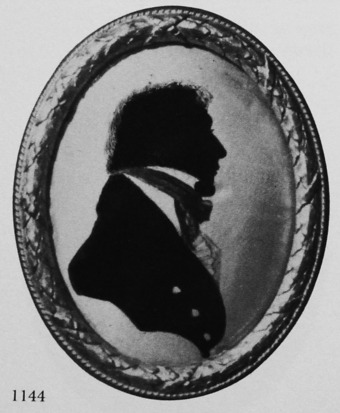
Unknown man
Silhouette painted on glass, backed with silk
c. 1810
3 x 2 ½ in./77 x 64 mm.
Frame: papier mâché, with ormolu surround
Crown Copyright. Victoria and Albert Museum, No. P133-1922
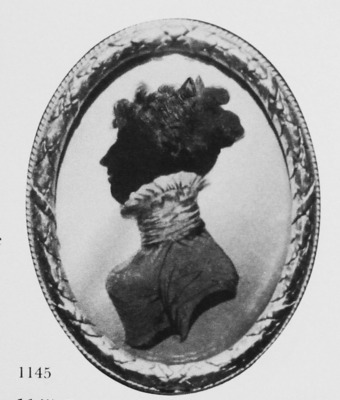
Unknown woman
Silhouette painted on glass, backed with silk
c. 1810
3 x 2 ½ in./77 x 64mm.
Trade Label
Frame: papier mâché, with ormolu surround
Comparison to the silhouette illustrated in 1144.
Crown Copyright. Victoria and Albert Museum, No. P130-1922
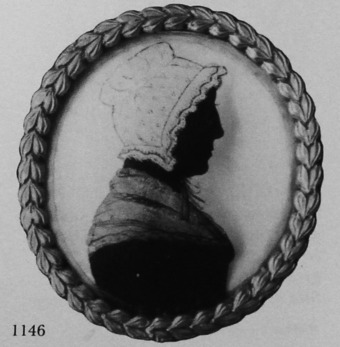
Unknown woman
Silhouette painted on convex glass, backed with composition
c. 1815
Diameter: 2 ½ in./64mm.
Frame: papier mâché, with ormolu surround
Attributed to Rogers on stylistic grounds.
D. S. Patton collection
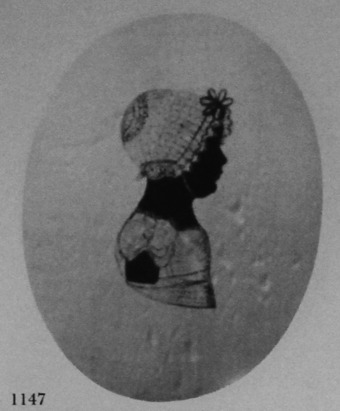
Unknown girl
Silhouette painted on convex glass, backed with silk
c. 1818
2 ¾ x 2 ½ in./70 x 64mm.
Attributed by specialists to Rogers.
The sitter was probably the daughter of a naval officer who has also the subject of a silhouette (158) by Rogers.
M. A. H. Christie collection
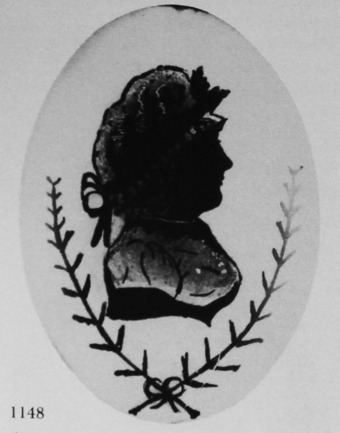
Locket of gilt metal, with leaf decoration, containing a silhouette of an unknown woman painted on convex glass, attributed on stylistic grounds to P. H. Rogers, c. 1812.
Size of locket: 2 ¼ x 1 3/8 in./58 x 35mm.
Author’s collection
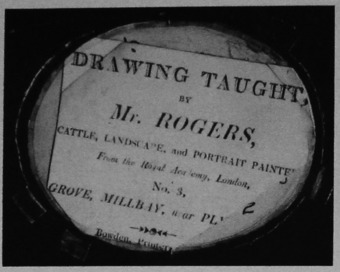
Trade label of P. H. Rogers, from the silhouette illustrated in 1145.
Crown Copyright. Victoria and Albert Musuem, No. P130-1922
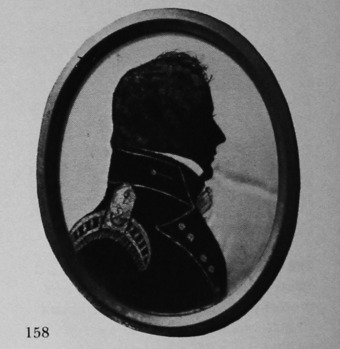
Officer of the British Navy
Silhouette by P. H. Rogers, c. 1818.
The stand-up collar indicates that the sitter is an officer, the gold lace binding that he is a lieutenant, and the arrangement of the buttons in pairs that he is a civilian office.
The officer’s strap shows the two crossed anchors which were to be standardized by the regulations of 1825, and probably indicate that the wearer is a purser.
M. A. H. Christie collection
SECTION THREE
